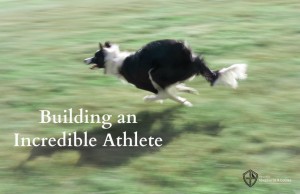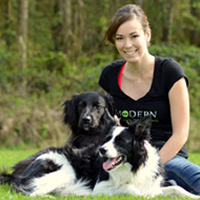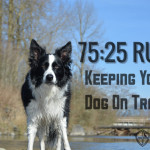Building an Incredible Athlete

Majority of the population are under the assumption that to have a well-behaved dog you need to just exercise the &#$% out of him or her and they will be so tired that they can’t practice bad/negative behaviours.
True..... to some extent. Your dog will be tired that day, but what about tomorrow and the day after?
Think about it for a second. What happens if you were to jog a mile today? If you've never jogged before, you'd be pretty tired, right? But what happens a couple weeks down the road, when you’ve jogged one mile every day? You're no longer exhausted from it, and you could probably go another half mile before feeling fatigued - am I right? YES. When we constantly run our dogs or walk them a mile per day, in an effort to tire them out, we’re always going to have to do more and more to tire the dog out. Soon, a one-hour walk that used to tire your six month old puppy out is a breeze for the one year old version.
You have a herding breed, so it’s pretty obvious that they are athletic; hopefully you understood this before getting one and enjoy this aspect of your dog, otherwise you should’ve gotten a Great Dane or Shih Tzu. Herding breeds, like Border Collies, Australian Shepherds, Kelpies, Shetlands and Heelers, are intense athletes and are considered the “top athletes of the canine world”, mainly because they are built for athletics and have the endurance to keep going. But should they?
Incredible Amounts of Exercise Will Create Incredible Endurance …
You are Building an Incredible Athlete!
You are basically training your dog for a marathon for when he or she turns two years old. Why would anyone (that is not a runner) want to do this? You're just going to constantly try to keep up with your amazingly fit dog and dedicate more time trying to tire him or her out. And what's going to happen when you can't keep up with a four-hour walk each day? Your dog will be so physically fit and used to being able to expel all this energy that your house will become a track field. Not fun for the floors or furniture.
Another problem that can happen is your dog becomes an adrenalin junkie. They get so used to being “high” that they can’t cope with any forms of relaxation and you’ll soon have a ‘Reactive Rover’ on the end of your leash because they’re wanting to feel alive again.
Now, I’m not saying “don’t exercise your dog that much” - quite the contrary, I’m saying “don’t over exercise your dog, and keep things ever-changing in their routine.
Let’s give a nice example here of a client of mine:
They have a very active dog and did thorough research on the breed. They were told that the dog needed TONS of physical exercise and room to run all day. So they gave it just that - they were dedicating 3-4 hours each day of purely physical stimulation to the dog, and constantly trying to tire the dog out as she grew older. They were joining dog sport clubs such as Flyball, just trying to keep her sated from destroying their house.
One year later, they met me. They tell me how much exercise they give this dog, and I'm looking at the crazy dog bouncing off the walls and running inside while I'm there. The owners say, "we've already been out two times today (1.5 hours already)!!!” This was 3pm. They looked absolutely exhausted, though I would be too.
I happily explained to them that they no longer have to take her to fields and run her until she drops - you should have seen the smiles on their faces ... priceless.
I instructed, as I tell many of my clients, don't think of your dog as a physical vessel, but that your dog has a brain and that needs to be exercised no matter what the breed is. We worked with the dog for 30 minutes on simple cues and tricks; the dog dropped on the floor and went to sleep five minutes after we finished tricking.
The problem was that the owners never thought to utilize the dog's brain. Yes, your dog has a brain! He isn't just a cute, furry thing. When you pair physical exercise with mental stimulation, such as games, tricks, obedience cues, playing and interacting one-on-one, you are training the dog's brain much like you train your muscles and the dog becomes tired without putting tremendous stress on the joints/muscles.
I’m a big fan of incorporating physical and mental stimulation into one session. Throwing a ball or Frisbee as the reward to doing a cue/behaviour; dog’s got to think hard to get that special reward, they get it right, they get a reward toy and to run, flip and have fun. Repeat this until the dog is happy and content – NOT DEAD TIRED.
Something to Try Tomorrow
If you have an active dog:
(1) twenty minute walk (morning or night)
(1) field/park outing (40 min) where they get to use their brain and body
(2) fifteen minute brain sessions (obedience, tricks, brain games)
This is 1.5 hours for a high-energy dog, per day (on average), with the exception of the weekends (these are days off) where you do extra fun things like swimming, hiking, playdates, etc. By following this routine, you will have the same results as taking your dog out for hours on end throwing a ball, but with a whole lot less stress on the dog’s body and more time for you to snuggle your dog.
Non-active dog? Cut the routine in half.
Tips: On walks, utilize their brains by training cues and commands such as heel, sit, swing to one side or the other, and an impulse control game with the leash (tug and leave it).
Article By:
Kris Crestejo, CDBC
Meet our Evangelist







